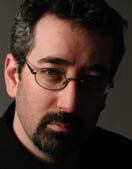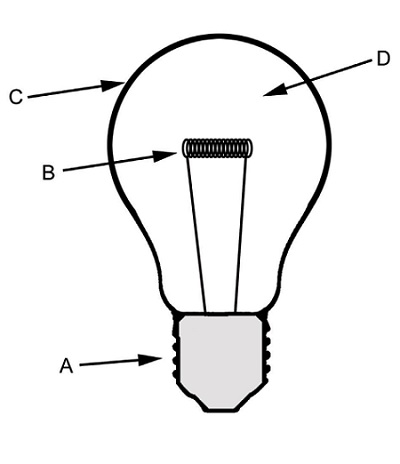Tungsten v. Incandescent

Jay Holben
This month, let’s take a deeper look at one of the most ubiquitous forms of illumination in our world: tungsten or incandescent bulbs.
Incandescent means light from heat, which also includes the light from the sun and from fire.
The light bulb, originally refined (although not invented) by Thomas Edison, features a base (traditionally a medium screw base), two electrodes, a filament coil (most commonly of tungsten) and a glass envelope (bulb) to enclose the filament in an oxygen-less vacuum (Fig. 1).
When current is applied to the positive electrode, the electrons pass from the electrode through the filament to the other electrode. The movement through the tungsten, along with resistance to the flow of electrons, causes the filament to heat up to the point where it begins to incandesce— or emit light from the heat.
Tungsten, a naturally occurring metal, is a very brittle substance, but it has the highest melting point of non-alloyed metals and the second highest melting point of all elements on the periodic table. This makes it perfect for the source of incandescence as the standard tungsten filament can heat up to temperatures of more than 5,000 degrees Fahrenheit.

Fig. 1: The traditional light bulb, features a base (traditionally a medium screw base), two electrodes, a filament coil (most commonly of tungsten) and a glass envelope (bulb) to enclose the filament in an oxygen-less vacuum. With that extreme heat, if oxygen were present inside the bulb, the filament would simply burst into flames and burn out. Instead, we fill the bulb with an inert gas, most often argon or nitrogen. Since the tungsten is a delicate and brittle substance, it will start to deteriorate through usage. Small particles of tungsten will fall off of the filament and collect on the coolest part of the bulb (this is the blackening you see on older light bulbs).
The glass of the bulb—called the envelope—must also be able to withstand the intense heat inside the bulb. Common bulbs have a borosilicate envelope, and the glass bulb is large enough to position good space from the hot filament, or the glass would actually melt.
TUNGSTEN-HALOGEN
Many people misuse the term “halogen” with regard to incandescent lamps. This refers to a specific class of bulb, not the standard light bulb. Tungsten-halogen or merely halogen bulbs are filled with argon and nitrogen and an additional halogen gas, most commonly iodine (sometimes bromine, chlorine, fluorine or astatine).
This additional gas, when heated, captures loose particles of tungsten and re-deposits them back onto the filament, which prolongs the life of the bulb. This process requires the filament to burn at a higher temperature than the standard incandescent bulb and, as a result, also requires a much thicker and robust envelope; generally quartz glass.
Since these bulbs burn hotter, they actually also have a higher color temperature than standard household bulbs. Standard bulbs are 2,600 to 2,800 Kelvin, whereas halogen bulbs are 2,900 to 3,200K, which makes them more beneficial for use in photography. The thicker, higher-melting point, quartz glass also allows for less required space between the envelope and the filament, making tungsten-halogen bulbs much more compact.
BAN ON INCANDESCENT LIGHT BULBS
Environmental movements have created a legal ban on standard incandescent light bulbs. The United States has the “Energy Independence and Security Act of 2007,” but there is similar legislation in other countries all around the world. It’s not a true ban, per se; the law requires a certain efficiency of electrical usage: 25 lumens per watt by 2013 and 60 lumens per watt by 2018. Standard incandescent bulbs have an efficiency of about 10–20 lumens per watt, so they just can’t meet the new standards. This phase-out has been happening since 2008. In 2012, 100-watt bulbs were phased out. In 2013, 75 W and as of January 2014, 60 W and 40 W bulbs are being phased out.
INCANDESCENT LIGHT: PROS AND CONS
Pros
• As an incandescent source, tungsten lamps are “full spectrum,” meaning they emit all the colors of the rainbow.
• Incandescent bulbs can be easily dimmed using standard dimmers.
• There is no problem with “flicker” with incandescent lamps—at any frame rate or shutter speed.
Cons
• Between 80 and 90 percent of the energy used is wasted on heat.
• As a result, they generate a lot of heat.
This ban only covers standard household bulbs. Specialty bulbs, like those used in professional lighting fixtures for our industry, are not affected. Also, “rough duty” bulbs are still legal to manufacture and sell, as are bulbs with unusual bases.
Some clever manufacturers have found a way around the ban by inserting small halogen “special duty” bulbs inside the envelope of a traditional medium base bulb. These have the benefit of being more energy- efficient than standard tungsten light bulbs and, for us, they burn at a more “pure” color temperature than standard tungsten— win, win!
Jay Holben is the technical editor of Digital Video and a contributor to Government Video. He is also the author of the book “A Shot in the Dark: A Creative DIY Guide to Digital Video Lighting on (Almost) No Budget.”
Get the TV Tech Newsletter
The professional video industry's #1 source for news, trends and product and tech information. Sign up below.
